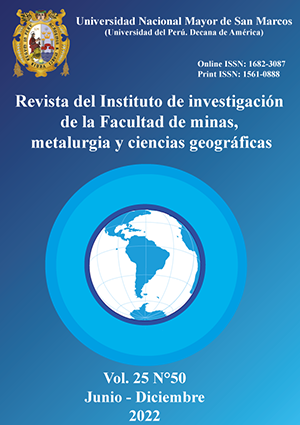Evidencia geoquímica y geocronológica del Batolito de Pataz entre los paralelos 8°10´S - 8°17´S
DOI:
https://doi.org/10.15381/iigeo.v25i50.24323Palabras clave:
Batolito, facie, orogénico, petrología, geoquímica, coetaneidad, geocronologíaResumen
El Batolito de Pataz del Carbonífero (Missisipiano), datado entre los 329 – 347 Ma (Haeberlin et al., 2004), tiene aproximadamente 160 km de largo (N30°O) y un ancho de 2.5 a 5 Km actualmente reconocidos. El intrusivo está constituido por más de una facies plutónica; una facies de granito – granodiorita y otra facies de tonalita - diorita, siendo la primera la más favorable para el emplazamiento y desarrollo de las vetas del tipo orogénico con contenido aurífero.
La zona de estudio se emplaza entre los paralelos 8°10´S a 8°17´S, entre las localidades de Llacuabamba y Tayabamba de la provincia de Pataz, Perú, los estudios realizados a los intrusivos aflorando en las inmediaciones de la localidad de Tayabamba habrían mostrado una similitud petrológica y geoquímica al Batolito de Pataz, la afinidad de todas las muestras hacia granitos de arco volcánico, así como una similitud en el ratio SiO2 vs Sm/Yb, hace presumir una posible coetaneidad de los pulsos cristalinos (Mantle & Collins, 2008), esto ha sido corroborado con los resultados geocronológicos U-Pb obtenidos, los cuales colocan a los intrusivos de la zona de estudio entre los 333 – 335 Ma, afirmando con esto la continuidad del Batolito de Pataz hacia el Sur.
Descargas
Publicado
Número
Sección
Licencia
Derechos de autor 2022 Willy López Mogrovejo, José Andrés Yparraguirre Calderón, Jaime César Mayorga Rojas

Esta obra está bajo una licencia internacional Creative Commons Atribución 4.0.
LOS AUTORES RETIENEN SUS DERECHOS:
a. Los autores retienen sus derechos de marca y patente, y tambien sobre cualquier proceso o procedimiento descrito en el artículo.
b. Los autores retienen el derecho de compartir, copiar, distribuir, ejecutar y comunicar públicamente el articulo publicado en la Rev. Inst. investig. Fac. minas metal cienc. geogr. (por ejemplo, colocarlo en un repositorio institucional o publicarlo en un libro), con un reconocimiento de su publicación inicial en la Rev. Inst. investig. Fac. minas metal cienc. geogr.
c. Los autores retienen el derecho a hacer una posterior publicación de su trabajo, de utilizar el artículo o cualquier parte de aquel (por ejemplo: una compilación de sus trabajos, notas para conferencias, tesis, o para un libro), siempre que indiquen la fuente de publicación (autores del trabajo, revista, volumen, numero y fecha).
























